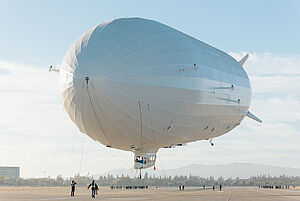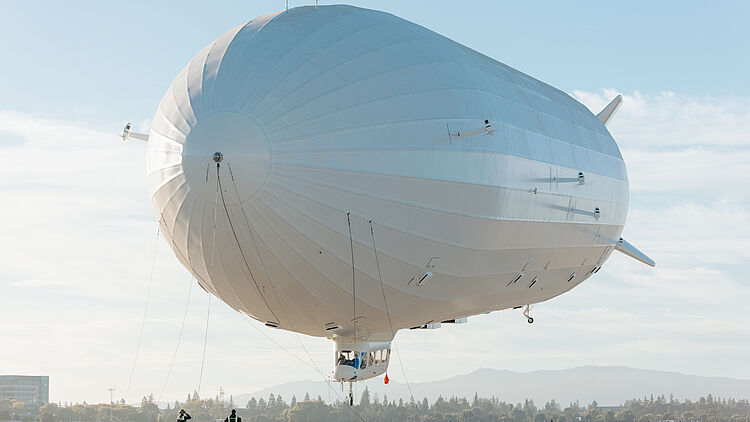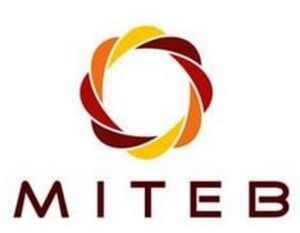International Conference On Electric Airships - Challenges for Commercialization
10141Flexible thin-film solar cells, highly efficient power electronics, and lightweight batteries enable the construction of a new generation of airships. This includes drones, high altitude airships, and airships for cargo and passenger transport. In particular, airships can be used in the future for:
- transport to remote areas
- sustainable cargo transport
- transport of heavy loads
- sustainable passenger transport
- monitoring and surveillance of e.g. pipelines, high power transmission lines
- provision of telecom and internet connections
- tourism transport, recreation, and sightseeing
- humanitarian aid, disaster relief

Airship “Pathfinder 1”
- A proof-of-concept vehicle designed and manufactured by LTA Research
- flies untethered at Moffett Field in Mountain View, California.
The conference covers technical aspects as well as applications and environmental aspects.
Conference Topics:
- Construction and design of airships
- Construction of low and high altitude drones
- Sustainable aviation by airships
- Power electronics and batteries for airships
- Solar energy for airships
- Application of airships
- Usage of hydrogen as energy source and lifting gas
- Certification, regulation and integration in existing aerospace
- Infrastructure, ground handling of airships
Summary overview for all days
(Note: Childcare available upon request)
| Sept. 24th | Sept. 25th | Sept. 26th | Sept. 27th | |
|---|---|---|---|---|
| 08:00 a.m. - 8:30 a.m. | - Registration Location: Energie Campus Nürnberg | - Networking Location: Energie Campus Nürnberg | ||
| 8:30 a.m. - 6:00 p.m. | - Conference, Coffeebreaks, Lunch - Poster Session with evening Snack Location: Energie Campus Nürnberg | - Conference with Discussion, Coffeebreaks, Lunch Location: Energie Campus Nürnberg | - SPECIAL Sightseeing at 10:30 a.m. with Prof. Thomas Weber "Nuremberg during World Wars of Disinformation and Demagoguery: A Walking Tour of the Zeppelin Field" | |
| 7:00 p.m. - 10:00 p.m. | - Registration and Casual Welcome Meeting Location: Adina Hotel, Dr. Kurt-Schumacher-Str. 1, Nürnberg | - Reception Location: DB Museum, Lessingstr. 6, Nürnberg With: Bavarian Minister of the Interior Joachim Herrmann, Alexandra Mehnert, Member of European Parliament | - Conference Dinner Location: Mautkeller, Hallplatz 2, Nürnberg |
Speakers & Topics 25th of September, 2025:
Abstract submission for presentations and posters is open
Prof. Carlo Riboldi, Politecnico di Milano
On the technical and economic feasibility of unmanned airships: a comparative study
This contribution discusses the profitability of unmanned LTAs, based on the comparison of purpose-designed LTA platforms vs. multi-copter and fixed-wing UAVs, as well as manned helicopters, considering three missions currently flown by these flying machines and compatible with the technical abilities of small-scale, autonomously-flying LTAs.
Barry E. Prentice, ISO Polar Airship Assoc
Airships for Mining Critical Mineral
New technologies that require rare earth minerals for magnets, batteries, and electronics have created a growing demand, while trade issues have reduced supply from China. Canada is a potential beneficiary because 32 different critical mineral deposits are known to exist in the North. The problem is obtaining access. The distances are too long and the costs of building roads in too high. This has created market for cargo airships that is large enough to sustain a new manufacturing industry. This presentation sets out the economics and potential of cargo airships to accessing critical mineral in remote locations.
Prof. Lei Zhou, China Special Vehicle Research Institute (virtual)
AS700D - the Development of Electric Version of the AS700 Airship
The AS700D represents a fully electric evolution of the AS700 airship platform, featuring 100% battery-powered propulsion. This advanced model replaces conventional systems with electric drive technology through two key modifications:
1. Power System Conversion: Traditional fuel system replaced with high-capacity Li-ion battery arrays.
2. Propulsion Upgrade: Combustion engines replaced by efficient electric drive motors; Integrated digital control system for precision operation.
The lithium-ion battery configuration delivers clean, sustainable operation while maintaining the AS700 platform's core capabilities. This electric variant demonstrates significant progress in eco-friendly airship technology development.
Gennadiy Verba - Atlas
Nathanael West, England
Energy efficiency of airships and airplanes
Airships are generally assumed to be more energy efficient than aeroplanes. However, this presumed efficiency advantage has not yet been appropriately quantified in the pertinent academic literature. This talk aims to fill this gap. It also evaluates airships and aeroplanes in terms of their compatibility with future renewable energy carriers.
Alexander Richter, TU Berlin
Development of numerical fin sizing method for airships
In preliminary airship design fin sizing is a challenging task due to very complex flight mechanics and coupling effects between the envelope and the fins. The presentation will show a statistical method to assess airship stability using basic fin parameters. With estimating the lift carry-over effect, the mothod enables fast design evaluations.
Prof. Dr. Gerd Hirzinger, Germany
Introduction to Virtual Reality of Rigid Airship Hindenburg
Don’t miss this unique experience!
Spencer Horne, Founder and CEO of Cloudline, South Africa
Solar Airships: What Price Scale?
As solar airship technology matures beyond proof-of-concept demonstrations, the fundamental question of optimal scale becomes central to its commercial success. This presentation examines the relationship between airship size and solar power integration, drawing parallels to Von Karman and Gabrielli's classic analysis of speed-power relationships in aircraft design, through the lens of our experiences in building at Cloudline.
Daniel Wibbing, Roboloon, Germany
Environmental Robustness of Unmanned Airships
For a long time aerial inspections of our energy and mobility infrastructures have been carried out by noisy, fuel guzzling helicopters. Today new kinds of small unmanned airships are trying to replace them. How can they achieve the required pin point accuracy even under adverse environmental conditions? Daniel Wibbing from roboloon will give us insights into his experiences with the matter.
Josef Rokůsek, HyLight, France
HyLight Drone Video Show
Piers Olsen, Chairman of Olsen Actuators & Drives
Propellor pitch actuation
Olsen Actuators & Drives is a UK engineering company specializing in the design and manufacture of high precision electro-mechanical actuator systems - both linear and rotary - including associated servo drives, motors, encoders and bespoke XYZ gantry solutions. Their products are used in demanding sectors such as aerospace, defense, marine, space, eVTOL and industrial automation.
Christian Bentheimer Fraunhofer IISB, Germany
Cryogenic Power Electronics and Superconducting Aircraft Powertrains
Superconducting technologies will be a key enabler for the electrification of future hydrogen-electric powered aircraft. It will lead to performance improvements of the propulsion system, translating into significant weight and fuel saving potential. The presentation gives an insight about the design basics and challenges of cryogenic powertrains.
Raffaello Terenzi, Politecnico di Milano
IPROP: Pioneering Ionic Propulsion for Next-Generation Stratospheric Airships
The IPROP project advances ionic air-breathing propulsion toward stratospheric airships capable of replacing satellite functions. A demonstrator airship will showcase silent, emission-free ionic thrusters. The airship will be optimized to enable the propulsion units to operate under the most favorable conditions. The project fully investigates integration between ionic thrusters and airship platforms, unlocking sustainable, long-endurance solutions for telecommunications and sensing.
Speakers & Topics 26th of September, 2025:
Prof. Dr. Christoph Pflaum, Professorship for Computer Science, Friedrich-Alexander-Universität Erlangen-Nürnberg (FAU)
Influence of Clouds to Solar Powered Large Airships
Prof. Dr. Rajkumar Sureshchandra Pant, Indian Institute of Technology Bombay
Conceptual Sizing and Environmental Assessment of Rigid Cargo Airships
This presentation will showcase a sizing methodology for conceptual design of Rigid Cargo Airships, by building upon and refining century‑old textbook models with empirical data drawn from historical rigid airships. Additionally, a methodology for quantifying the environmental impact of the historic rigid airship USS Macon will be presented, and the results will be benchmarked against major contemporary transport modes.
Sylvain Allano, Flying Whales, France
Contribution of solar energy to the global Information-Energy system of a cargo airship
Although it is clear that solar cells placed on or in the envelope of a cargo airship could not alone meet the power requirements for hovering operations, recent progress made in solar textiles makes it possible to consider their use for specific functions within the airship. However, their impact on the thermodynamics of the airship will have to be taken into account, with the risk of uncontrolled heating of the helium cells.
Robin Deransy, Head of Unit, Eurocontrol Innovation Hub Paris
Moderation of discussion on European Policies regarding Lighter-Than-Air (LTA) Technology:
As a representative of one of Europe’s leading aviation institutions, Robin will moderate an interactive session exploring the challenges and opportunities for scaling up LTA technology within the EU. The discussion will aim to identify key impediments to deployment and examine associated regulatory hurdles. It will also shed light on ongoing European initiatives supporting LTA advancement and consider strategies to accelerate progress. The objective is to identify concrete actions that can drive innovation and stimulate sectoral growth across the continent.
Dr. Frank Neumann, Institute for Infrastructure, Environment and Innovation (IMIEU)
New Airship Technology - Challenges and Opportunities in the evolving regulatory context for Airships in Europe
Prof. Patrick Hendrick, ULB - Université Libre de Bruxelles
Airship Drones: H2 vs. Helium as lifting gas
The presentation will highlight the advantages and drawbacks of using hydrogen as the lifting gas of LTA UAVs, including the use of H2 for the (electric) propulsion system of the LTA drones.
Udo Berthold, MITEB, Germany
Safety Aspects for Unmanned Airships
The principle of “lighter than air” generates a fundamentally different behavior of the aircraft with regard to risks on the ground and in the air. Making sensible use of the intrinsic safety advantages can open up new application potential, for example when flying beyond visual line of sight and over densely populated areas.
Bonnet-Eymard Bénédicte, CSEM Neuchâtel, Switzerland
Lightweight solar modules implementing advanced polymer materials and solar cells
With a decade of expertise in lightweight solar modules, CSEM has crafted specialized PV products for applications demanding minimal added weight and high power output with precise assessment, design, and installation for optimal integration. This talk will highlight past achievements and explore future possibilities.
Oliver Gochermann, Managing Director, Gochermann Solar Technology
Bespoke solar arrays in mobile applications past achievements, current developments, future goals
Simon Gehringer, Fraunhofer / Evolonic
VLMs onboard of airships for scene understanding in a wildfire context
Early wildfire detection is critical for effective suppression efforts. While CV techniques offer reliable fire detection, they often lack contextual understanding. To address this VLMs were utilized to generate structured scene descriptions from UAV imagery. To achieve long flight times, airships are used as the platform. Our results demonstrate, that such compact VLMs, that can be run onboard the airships, can provide rich contextual information.
Ross Prentice, CEO BASI
Drone airships for wildfire early detection and prevention
Sensor technology is available to spot heat signatures of potential forest fires, at great distances. The missing piece is an airship platform to carry these sensors. Almost any airship can do this, where BASI’s project differs, is that it is designed to carry quadcopters that can be dispatched to extinguish small fires before they get too large.
Hannah Reindle, Technical University of Munich, Institute of Flight System Dynamics
Research Platform Airship
To enable research flights over complex urban areas, the institute of Flight System Dynamics of TUM developed a medium-sized blimp. With a payload capacity of up to 15 kg, the airship provides sensor-carrying capabilities for investigations in the context of advanced air mobility. Besides the presentation of the features of the airship and the results of the project, this talk points out why it is advantageous to use an airship as a research platform, especially in urban environment.
Price information
(all prices incl. VAT)
Conference ticket includes meals and beverages during the day.
| Regular Ticket | Early Bird 300€ / Late Registration 380€ |
| Student Ticket | 50€ |
| Welcome Meeting (Wednesday) | 20€ |
| Conference Dinner (Friday) | 60€ |
| Sightseeing (Saturday) | 30€ |
| Total Package (includes conference, dinner and sightseeing) | 380€ |
Conference Committee
- Prof. Dr. Christoph Pflaum (FAU)
- Prof. Dr. Christoph Brabec (FAU, Helmholtz-Institut Erlangen-Nürnberg)
- Prof. Dr. Martin März (FAU, Fraunhofer-Institut IISB)
- Dr. Frank Neumann (IMIEU)
- Prof. Dr. Barry Prentice (University of Manitoba)
- Prof. Carlo Riboldi, Politecnico di Milano, Department of Aerospace Science and Technology
- Prof. Patrick Hendrick, University of Brussels, Aerospace Department (ULB/ATM)
Contact Information
Prof. Dr. Christoph Pflaum
Department of Computer Science
Professorship for Computer Science (Numerical Simulation using Highest-Performance Computers)
Phone number: +49 9131 85-28692
E-Mail: christoph.pflaum@fau.de
Sponsors




